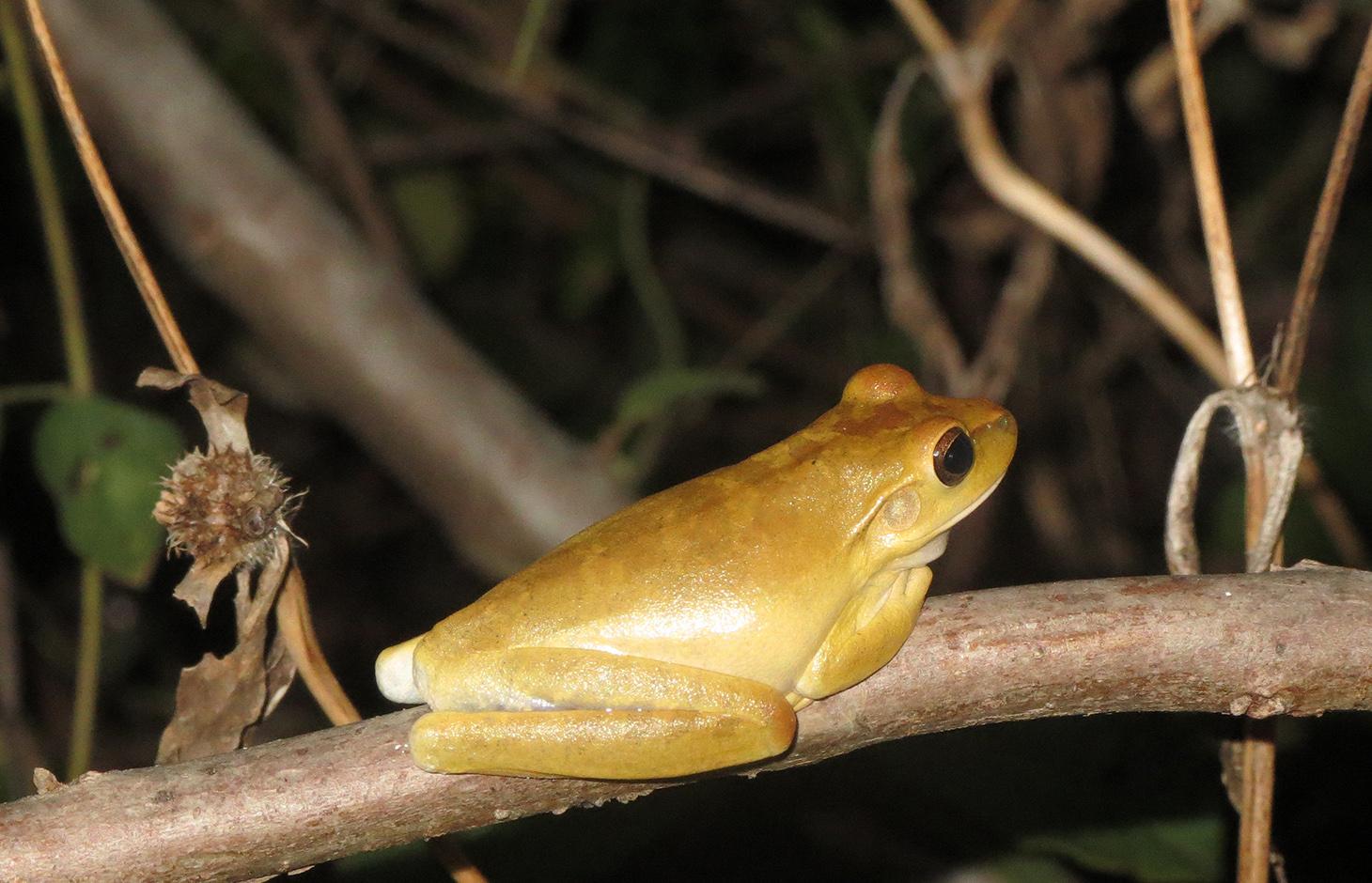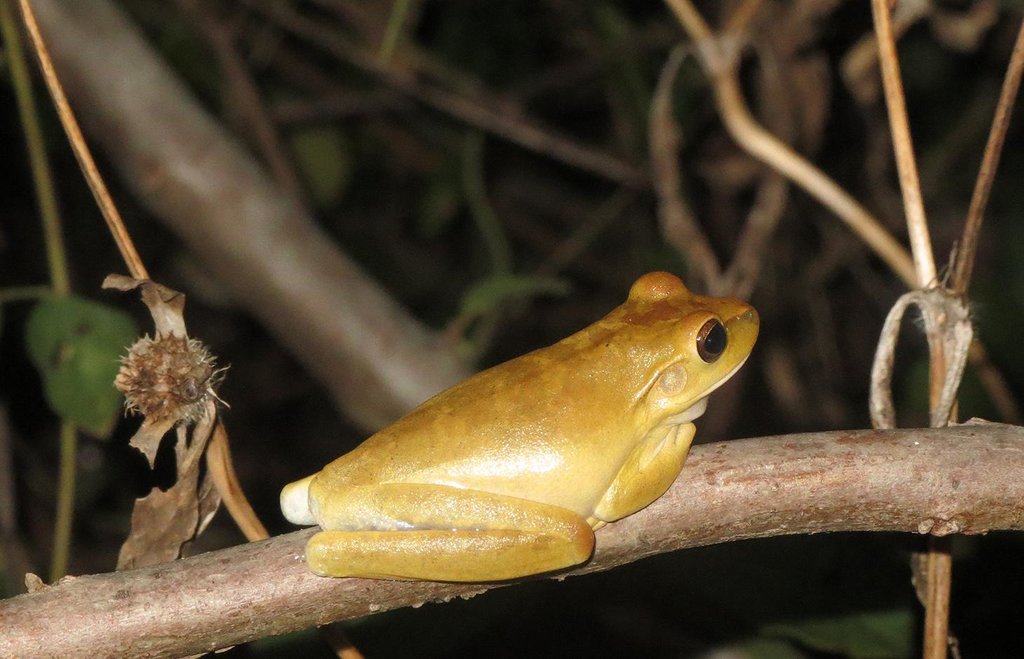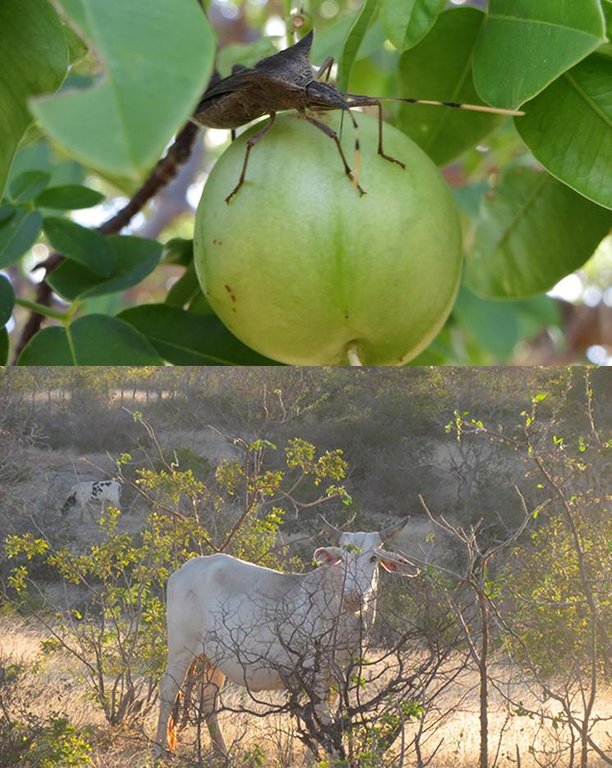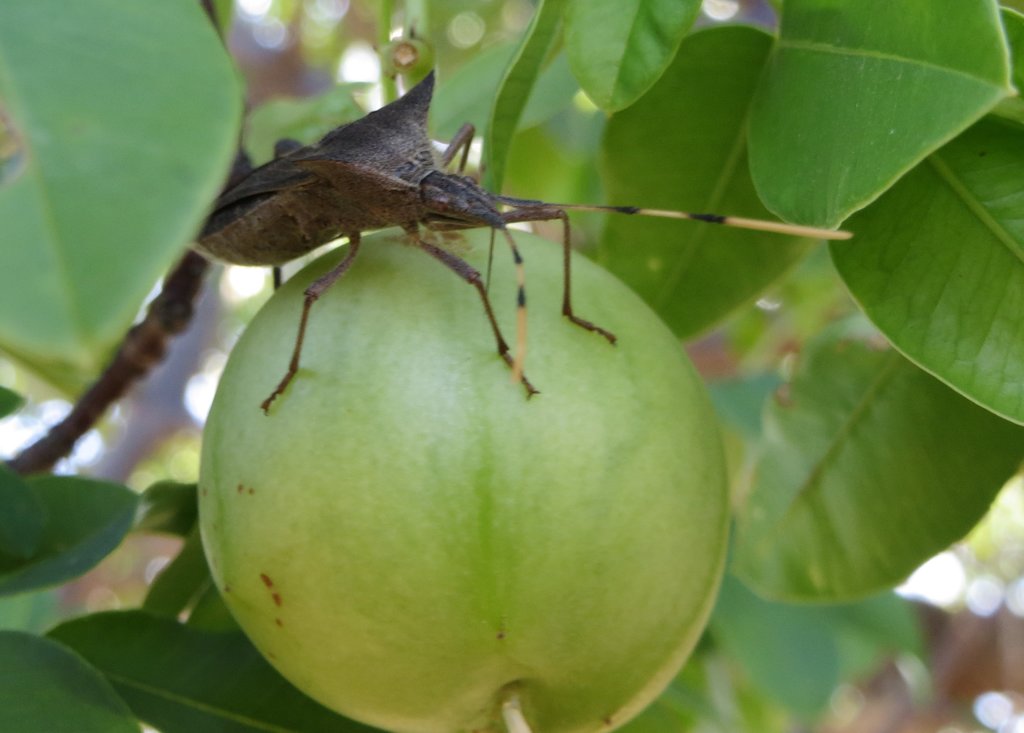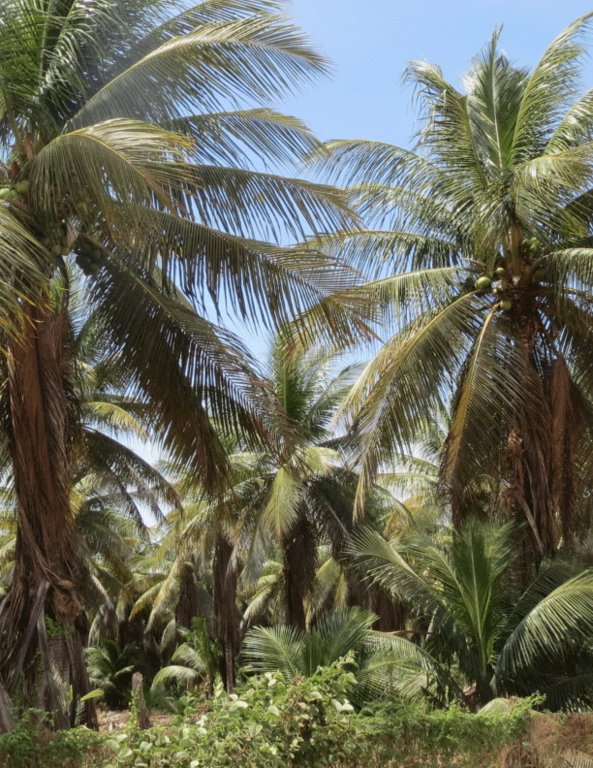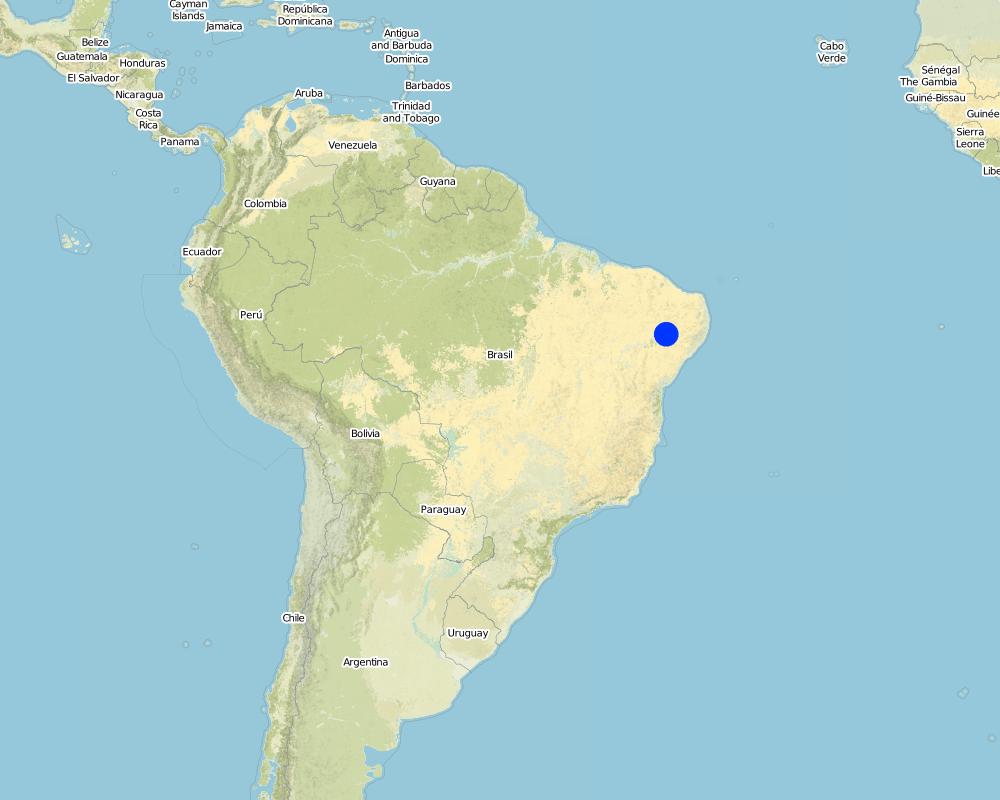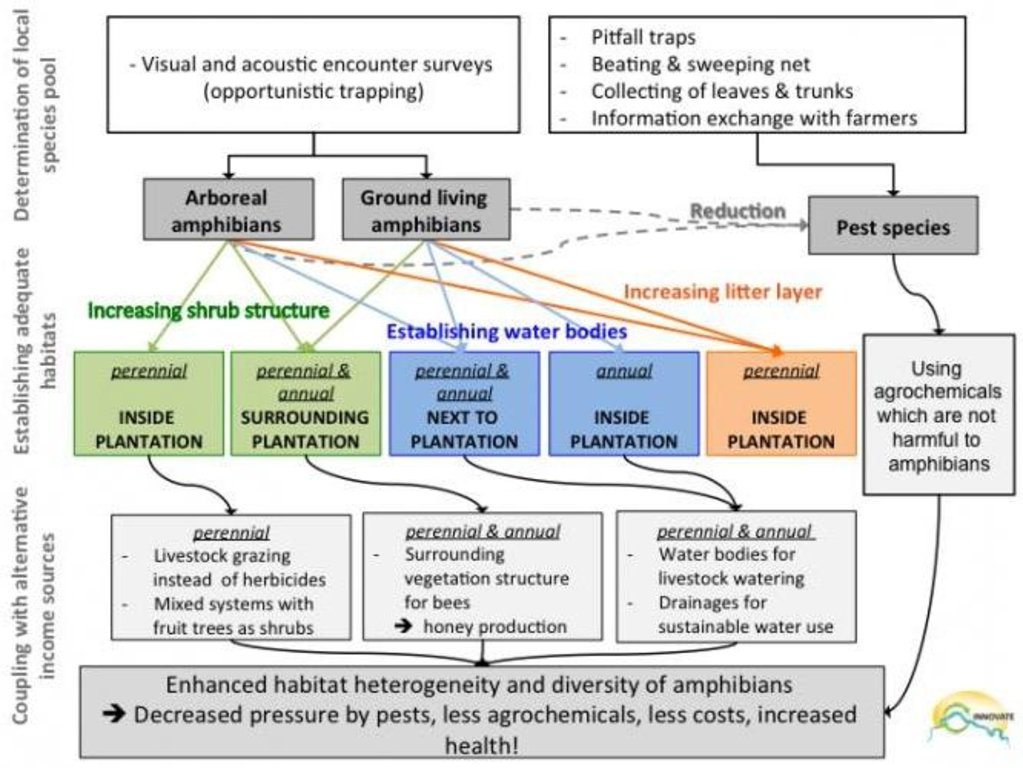Biological pest control through promoting habitats for native fauna [บราซิล]
- ผู้สร้างสรรค์:
- การอัพเดท:
- ผู้รวบรวม: Marianna Siegmund-Schultze
- ผู้เรียบเรียง: –
- ผู้ตรวจสอบ: Fabian Ottiger, Alexandra Gavilano
Controle biológico de pragas pela fauna nativa: manter ou restabelecer habitats respectivos (Portuguese)
technologies_1293 - บราซิล
ดูส่วนย่อย
ขยายทั้งหมด ย่อทั้งหมด1. ข้อมูลทั่วไป
1.2 รายละเอียดที่ติดต่อได้ของผู้รวบรวมและองค์กรที่เกี่ยวข้องในการประเมินและการจัดเตรียมทำเอกสารของเทคโนโลยี
ผู้เชี่ยวชาญ SLM:
Biologist:
Ernst Raffale
Senckenberg Natural History Collections Dresden
Koenigsbruecker Landstr. 159, 01109 Dresden, Germany
เยอรมนี
ผู้เชี่ยวชาญ SLM:
Hagel Heinrich
heinrich.hagel@uni-hohenheim.de
Universit of Hohenheim
Wollgrasweg 43, D-70599 Stuttgart, Germany
เยอรมนี
ชื่อของโครงการซึ่งอำนวยความสะดวกในการทำเอกสารหรือการประเมินเทคโนโลยี (ถ้าเกี่ยวข้อง)
Book project: Making sense of research for sustainable land management (GLUES)ชื่อขององค์กรซึ่งอำนวยความสะดวกในการทำเอกสารหรือการประเมินเทคโนโลยี (ถ้าเกี่ยวข้อง)
Universität Hohenheim - เยอรมนีชื่อขององค์กรซึ่งอำนวยความสะดวกในการทำเอกสารหรือการประเมินเทคโนโลยี (ถ้าเกี่ยวข้อง)
Senckenberg Natural History Collections Dresden - เยอรมนีชื่อขององค์กรซึ่งอำนวยความสะดวกในการทำเอกสารหรือการประเมินเทคโนโลยี (ถ้าเกี่ยวข้อง)
Technische Universität Berlin (Technische Universität Berlin) - เยอรมนีชื่อขององค์กรซึ่งอำนวยความสะดวกในการทำเอกสารหรือการประเมินเทคโนโลยี (ถ้าเกี่ยวข้อง)
Leibniz-Institut für Gewässerökologie und Binnenfischerei (IGB) - เยอรมนีชื่อขององค์กรซึ่งอำนวยความสะดวกในการทำเอกสารหรือการประเมินเทคโนโลยี (ถ้าเกี่ยวข้อง)
Potsdam-Institut für Klimaforschung (PIK) - เยอรมนี1.3 เงื่อนไขการใช้ข้อมูลที่ได้บันทึกผ่านทาง WOCAT
วันที่เก็บรวบรวมข้อมูล(ภาคสนาม) :
01/01/2014
ผู้รวบรวมและวิทยากรหลักยอมรับเงื่อนไขเกี่ยวกับการใช้ข้อมูลที่ถูกบันทึกผ่านทาง WOCAT:
ใช่
2. การอธิบายลักษณะของเทคโนโลยี SLM
2.1 การอธิบายแบบสั้น ๆ ของเทคโนโลยี
คำจำกัดความของเทคโนโลยี:
Reducing the use of common agrochemicals by supporting preferred habitats of biological pest control agents like amphibians and by using alternative self-made organic pesticides.
2.2 การอธิบายแบบละเอียดของเทคโนโลยี
คำอธิบาย:
Irrigated crops attract various pest species. Farmers usually address crop pest and disease problems through the use of agrochemicals. Especially bees, birds, and amphibians, which fulfil important functions in agroecosystems, are affected by high use of agrochemicals. The combination of inappropriate irrigation practices, incorrect application rates of agrochemicals, and low producer prices often lead, however, to poor income from smallholder irrigated agriculture and to further problems such as poor health, loss of biodiversity, and soil and water contamination. Amphibians are themselves proven biological pest control agents of arthropod pest species (predators of e.g. larvae of butterflies, beetles, termites, bugs and others) and the incorrect use of agrochemicals, as well as the removal of vegetation along field margins hampers this useful function. The technology described here aims to support and utilise the potential of amphibians (such as frogs and toads) as biocontrol agents –as an alternative to agrochemicals in crops.
Purpose of the Technology: Establishing habitats for amphibians is crucial in order to increase and secure their numbers: for example encouraging shrubby vegetation next to water bodies for arboreal frogs, and installing additional water ponds inside and around plantations for ground-living frogs. First, the local species pool of amphibians needs to be determined by visual and acoustic observations. Amphibian species do not need to be determined precisely, but it is important to detect whether they are arboreal and/or ground-living amphibians, as these two groups have different roles as biocontrol agents. Pests that feed on the main cultivated species should be characterized by (a) collecting plant material to determine the type and quantity of pests and (b) by comparing observations with neighbouring farmers and extension agents. Pest species can be determined also by installing traps and using nets. Inspection should be done at least every 15 days to once a month during the whole rainy season to detect possible mass reproduction of arthropods after rainfall events. Once amphibians and pest species are detected, decisions on management strategies can be made. Such a strategy is to create habitats for amphibians with additional sources of income, e.g. by planting pomegranate or guavas as shrubby vegetation structure for arboreal frogs. If pest species can't be reduced solely by amphibian species, the use of agrochemicals has to be reconsidered. Preference shall be given to chemicals which do not harm amphibians. Organic, self-made pesticides based on the extract of manioc roots (manipoera) seem promising. Twenty litres of manipoera, the bark of manicoba tree (Manihot pseudoglaziovii), a cup of American wormseed (Dysphania ambrosioides), a cup of yellow tagetes (Tagetes sp.), a cup of malagueta pepper (Capsicum sp.), garlic and a little bit of bleach have to be chopped, mixed and fermented for 10 days. Application of the final product (25 ml of organic pesticide diluted in 20 l of water) should be done every 8 to 15 days depending on crop species.
Natural / human environment: Increasing habitat heterogeneity stimulates the diversity of amphibians and so a greater number of pest types will be controlled. Combined control by safeguarding natural amphibian habitats and application of organic pesticides is an innovative alternative to the overuse of toxic agrochemicals.
2.3 รูปภาพของเทคโนโลยี
2.5 ประเทศภูมิภาค หรือสถานที่ตั้งที่เทคโนโลยีได้นำไปใช้และได้รับการครอบคลุมโดยการประเมินนี้
ประเทศ:
บราซิล
ภูมิภาค/รัฐ/จังหวัด:
Floresta, Itacuruba, Petrolandia
ข้อมูลจำเพาะเพิ่มเติมของสถานที่ตั้ง :
Brazil, Pernambuco
Map
×2.6 วันที่การดำเนินการ
ถ้าไม่รู้ปีที่แน่นอน ให้ระบุวันที่โดยประมาณ:
- มากกว่า 50 ปี (แบบดั้งเดิม)
2.7 คำแนะนำของเทคโนโลยี
ให้ระบุว่าเทคโนโลยีถูกแนะนำเข้ามาอย่างไร:
- ในช่วงการทดลองหรือการทำวิจัย
3. การจัดประเภทของเทคโนโลยี SLM
3.2 ประเภทของการใช้ที่ดินในปัจจุบันที่ได้นำเทคโนโลยีไปใช้

พื้นที่ปลูกพืช
- การปลูกพืชล้มลุกอายุปีเดียว
- การปลูกพืชยืนต้นที่ไม่มีเนื้อไม้
- การปลูกไม้ยืนต้น ไม้พุ่ม
พืชหลัก (พืชเศรษฐกิจและพืชอาหาร):
Major cash crop annual cropping: Watermelone, onion, beans, parsley, tomato, manioc
Major food crop annual cropping: Watermelone, onion, beans, parsley, tomato, manioc
Major cash crop perennial cropping: passion fruit, grape
Major food crop perennial cropping: passion fruit, grape
Major cash crop tree/shrub cropping: mango, coconut, pomegranat, guava, banana
Major food crop tree/shrub cropping: mango, coconut, pomegranat, guava, banana

การใช้ที่ดินแบบผสมผสาน (รวมถึงวนเกษตร)
- การปลูกพืชร่วมกับปศุสัตว์และการทำป่าไม้ (Agro-silvopastoralism)
ผลิตภัณฑ์หลักหรือบริการ:
Main species: Goat and sheep
Types of forest: Selective felling of (semi-) natural forests, clear felling of (semi-) natural forests, plantation forestry and shifting cultivation.
แสดงความคิดเห็น:
Major land use problems (compiler’s opinion): Intensive livestock grazing pressure, agriculture and logging of native vegetation are the driving factors behind loss of the Caatinga dry forest. The high use of agrochemicals additionally pollutes soils and watersheds, and probably also decreases local biodiversity. Droughts seem to occur more frequently and these decrease water and food availability for livestock, as well as affecting the local fauna.
Example for establishment of technology within study region: In the irrigation schemes of Petrolândia, Pernambuco, Brazil, the most important arthropod pest species in banana plantation was a weevil (Curculionidae, Coleoptera). The weevil (so called “moleque da bananeira”) attacked the roots of the banana plants, in consequence the plant tumbled down and was lost. As the weevil stays during the day in the ground and only starts moving during the night, it is difficult to combat this pest species by agrochemicals. With an increase of small water ponds with a shore vegetation structure (for example at 2 corners of the plantation) the abundance of ground-living amphibians increases and so the presence of amphibians in the banana plantation which feed on the weevil during the night.
Major land use problems (land users’ perception): Droughts and consequently problems of feeding livestock on natural vegetation (lack of fodder and grazing grounds), deforestation, extensive and inappropriate use of agrochemicals, low producer prices.
Nomadism: goat, sheep, cattle
Semi-nomadism / pastoralism: goat, sheep, cattle
Ranching: goat, sheep, cattle
Cut-and-carry/ zero grazing: goat, sheep, cattle
Improved pasture: goat, sheep, cattle
Mixed: (eg agro-pastoralism, silvo-pastoralism): goat, sheep, cattle
Selective felling of (semi-) natural forests: Yes
Clear felling of (semi-)natural forests: Yes
Shifting cultivation: Yes
Plantation forestry: Yes
Forest products and services: timber, fuelwood, fruits and nuts, grazing / browsing, other forest products / uses (honey, medical, etc.), nature conservation / protection
Livestock is grazing on crop residues
3.3 ข้อมูลเพิ่มเติมเกี่ยวกับการใช้ที่ดิน
จำนวนของฤดูเพาะปลูกต่อปี:
- 1
ระบุ:
Longest growing period from month to month: January to May
3.4 กลุ่ม SLM ที่ตรงกับเทคโนโลยีนี้
- การจัดการศัตรูพืชและโรคพืชแบบผสมผสาน (รวมถึงเกษตรอินทรีย์ด้วย)
- Biological pest control
3.5 กระจายตัวของเทคโนโลยี
ระบุการกระจายตัวของเทคโนโลยี:
- กระจายไปอย่างสม่ำเสมอในพื้นที่
ถ้าหากว่าเทคโนโลยีได้มีการกระจายออกไปอย่างสม่ำเสมอในพื้นที่ ให้ระบุปริมาณพื้นที่ที่ได้รับการครอบคลุมถึง:
- 0.1-1 ตร.กม.
แสดงความคิดเห็น:
The technology was carried out both in a forest system as well as in agricultural areas. An incrasing SLM Technology area is linked to an increasing sampling number.
3.6 มาตรการ SLM ที่ประกอบกันเป็นเทคโนโลยี

มาตรการจัดการพืช
- A1: พืช/สิ่งปกคลุมดิน

มาตรการอนุรักษ์ด้วยวิธีพืช
- V1: ต้นไม้และพุ่มไม้คลุมดิน
- V2: หญ้าและไม้ยืนต้น

มาตรการอนุรักษ์ด้วยโครงสร้าง
- S3: Graded ditches, channels, waterways
- S5: เขื่อน ชั้นดินที่แน่นแข็งบ่อน้ำ

มาตรการอนุรักษ์ด้วยการจัดการ
- M2: การเปลี่ยนแปลงของการจัดการหรือระดับความเข้มข้น
แสดงความคิดเห็น:
Main measures: agronomic measures, vegetative measures, structural measures, management measures
Type of agronomic measures: retaining more vegetation cover
3.7 รูปแบบหลักของการเสื่อมโทรมของที่ดินที่ได้รับการแก้ไขโดยเทคโนโลยี

การเสื่อมโทรมของดินทางด้านเคมี
- Cn (Fertility decline): ความอุดมสมบูรณ์และปริมาณอินทรียวัตถุในดินถูกทำให้ลดลงไป (ไม่ได้เกิดจากสาเหตุการกัดกร่อน)

การเสื่อมโทรมของดินทางด้านชีวภาพ
- Bc (Reduction of vegetation cover): การลดลงของจำนวนพืชที่ปกคลุมดิน
- Bh (Loss of habitat): การสูญเสียแหล่งที่อยู่
- Bs (Quality and species composition): องค์ประกอบหรือความหลากหลายทางคุณภาพและชนิดพันธุ์ลดลง
- Bp (Increase of pests/diseases): การเพิ่มขึ้นของศัตรูพืชและโรคพืช

การเสื่อมโทรมของน้ำ
- Hs (Change in quantity of surface water): การเปลี่ยนแปลงปริมาณของน้ำที่ผิวดิน
แสดงความคิดเห็น:
Main type of degradation addressed: Bc: reduction of vegetation cover, Bh: loss of habitats, Bs: quality and species composition /diversity decline, Bp: increase of pests / diseases, loss of predators, Hs: change in quantity of surface water
Secondary types of degradation addressed: Cn: fertility decline and reduced organic matter content
Main causes of degradation: crop management (annual, perennial, tree/shrub) (high use of agrochemicals, degradation of natural habitats), deforestation / removal of natural vegetation (incl. forest fires) (high logging and grazing intensity, no forest area without grazing!), overgrazing (high logging and grazing intensity, no forest area without grazing!), change in temperature (droughts become more frequently), change of seasonal rainfall (droughts become more frequently), Heavy / extreme rainfall (intensity/amounts) (less rainfall intensity), droughts (droughts become more frequently)
Secondary causes of degradation: urbanisation and infrastructure development (extending farmlands), population pressure (extending farmlands), poverty / wealth (farmers need to use natural resources as livestock fodder), education, access to knowledge and support services (less environmental awareness)
3.8 การป้องกัน การลดลง หรือการฟื้นฟูความเสื่อมโทรมของที่ดิน
แสดงความคิดเห็น:
Main goals: prevention of land degradation, mitigation / reduction of land degradation
Secondary goals: rehabilitation / reclamation of denuded land
4. ข้อมูลจำเพาะด้านเทคนิค กิจกรรมการนำไปปฏิบัติใช้ ปัจจัยนำเข้า และค่าใช้จ่าย
4.1 แบบแปลนทางเทคนิคของเทคโนโลยี
4.2 ข้อมูลจำเพาะด้านเทคนิคและการอธิบายแบบแปลนทางเทคนิค
Vegetation structures surrounding plantations beside waterbodies guarantee the occurrence of arboreal and ground-living amphibians. Arboreal frogs prefer shrubby vegetation. Since mowing or application of herbicides often eliminates shrubs, moderate livestock grazing might be a better option. The additional water bodies outside the plantation can thereby be used for livestock watering, as long as the surrounding vegetation structure is not eliminated through grazing. Fruit trees such as Guava or Pomegranate as shrub structure provide an additional source of income. To ensure the presence of ground-living frogs, smaller water bodies must be promoted within the plantation. Here puddles from leaky irrigation systems seem to be sufficient already.
Only agrochemicals and organic pesticides that are harmless to amphibians should be used as additional chemical pest control.
Date: 2016
Technical knowledge required for field staff / advisors: moderate (kowledge of habitat preference of important species and management issues)
Technical knowledge required for land users: low (kowledge of habitat preference of important species and management issues)
Main technical functions: increase in nutrient availability (supply, recycling,…), increase of biomass (quantity), promotion of vegetation species and varieties (quality, eg palatable fodder)
Secondary technical functions: control of dispersed runoff: retain / trap, control of dispersed runoff: impede / retard, control of concentrated runoff: retain / trap, control of concentrated runoff: impede / retard, control of concentrated runoff: drain / divert, increase of surface roughness, improvement of surface structure (crusting, sealing), improvement of topsoil structure (compaction), stabilisation of soil (eg by tree roots against land slides), increase in organic matter
Retaining more vegetation cover
Material/ species: herbs in planation of coconut, banana, guave, pomegranat etc.
Quantity/ density: dense
Change of land use practices / intensity level: less grazing in forest areas, less grazing at water ponds (fencing of a certain part of the pond), less cutting of shrubs and herbs in crop plantations (near to natural cutting by livestock)
4.4 กิจกรรมเพื่อการจัดตั้ง
| กิจกรรม | ประเภทของมาตรการ | ช่วงเวลาดำเนินการ | |
|---|---|---|---|
| 1. | Installing of additional small and large water bodies: a. large ponds outside the plantation (~100 m²/pond, ~ 4 ponds/plantation, one working day per pond) b. smaller ponds for ground-living frogs inside the plantation (one working day/ 5 ha). c. drainages can be installed instead of ponds outside the plantation for sustainable water use (machine rent) | ด้วยโครงสร้าง | |
| 2. | Planting shrubby vegetation or fruit trees outside and inside the plantation. Planting of Guava trees as shrubby vegetation: 25% density compared to Guava monoculture (e.g. 1.25 working days for exclusive Guava plantation) | ด้วยโครงสร้าง | |
| 3. | As irrigation was free in the study region, there were no costs calculated | ด้วยโครงสร้าง | |
| 4. | Knapsack sprayer for application of pesticides | ด้วยโครงสร้าง |
4.5 ค่าใช้จ่ายของปัจจัยนำเข้าที่จำเป็นสำหรับการจัดตั้ง
| ปัจจัยนำเข้า | หน่วย | ปริมาณ | ค่าใช้จ่ายต่อหน่วย | ค่าใช้จ่ายทั้งหมดต่อปัจจัยนำเข้า | %ของค่าใช้จ่ายที่ก่อให้เกิดขึ้นโดยผู้ใช้ที่ดิน | |
|---|---|---|---|---|---|---|
| แรงงาน | Labour | ha | 1.0 | 49.05 | 49.05 | 100.0 |
| อุปกรณ์ | Machine rent | ha | 1.0 | 100.0 | 100.0 | 100.0 |
| อุปกรณ์ | Knapsack sprayer | ha | 1.0 | 90.0 | 90.0 | 100.0 |
| วัสดุด้านพืช | Seedlings | ha | 1.0 | 75.0 | 75.0 | 100.0 |
| ค่าใช้จ่ายทั้งหมดของการจัดตั้งเทคโนโลยี | 314.05 | |||||
4.6 การบำรุงรักษาสภาพหรือกิจกรรมที่เกิดขึ้นเป็นประจำ
| กิจกรรม | ประเภทของมาตรการ | ช่วงระยะเวลา/ความถี่ | |
|---|---|---|---|
| 1. | Monitoring amphibian species at least 3 nights in the rainy season (can be done by the farmer himself) | ด้วยโครงสร้าง | |
| 2. | Monitoring of pest species (1 hour/ha) at least every 15 days in the rainy season (5 month/year) and once a month in dry season (7 month/year) (can be done by the farmer himself) | ด้วยโครงสร้าง | |
| 3. | Production and application of organic pesticides (25 ml of organic pesticide diluted in 20 l of water and applied every 8 to 15 days). Note: for commercial pesticides the application costs are the same. | ด้วยโครงสร้าง | |
| 4. | Application of fertilizer (1 working day/ year) | ด้วยโครงสร้าง | |
| 5. | Pruning of trees (5.25 working days(/year) | ด้วยโครงสร้าง |
4.7 ค่าใช้จ่ายของปัจจัยนำเข้าและกิจกรรมที่เกิดขึ้นเป็นประจำที่ต้องการการบำรุงรักษา (ต่อปี)
| ปัจจัยนำเข้า | หน่วย | ปริมาณ | ค่าใช้จ่ายต่อหน่วย | ค่าใช้จ่ายทั้งหมดต่อปัจจัยนำเข้า | %ของค่าใช้จ่ายที่ก่อให้เกิดขึ้นโดยผู้ใช้ที่ดิน | |
|---|---|---|---|---|---|---|
| แรงงาน | Labour | ha | 1.0 | 821.75 | 821.75 | 100.0 |
| ค่าใช้จ่ายทั้งหมดของการบำรุงรักษาสภาพเทคโนโลยี | 821.75 | |||||
แสดงความคิดเห็น:
To calculate the above example a scenario with maximum activities was taken. Any other scenario will be cheaper. Prices are from the year 2013. Real 1 = USD 0.3.. A total of 6 liters of concentrated organic pesticides per hectare per year are needed. This applies for both self-made and commercial pesticides. As commercial organic pesticides cost about USD 36 per liter, farmers spend USD 216 less per year for self-produced organic pesticides. Similarly commercial non-organic pesticides are more expensive compared to self-made organic pesticides. An additional income of USD 120 / ha / harvest were estimated for guava trees even under possible poor conditions like shadow and extensive management. Other additional sources of income are from the sale of self-produced organic pesticides and livestock grazing instead of using herbicides.
5. สิ่งแวดล้อมทางธรรมชาติและของมนุษย์
5.1 ภูมิอากาศ
ฝนประจำปี
- < 250 ม.ม.
- 251-500 ม.ม.
- 501-750 ม.ม.
- 751-1,000 ม.ม.
- 1,001-1,500 ม.ม.
- 1,501-2,000 ม.ม.
- 2,001-3,000 ม.ม.
- 3,001-4,000 ม.ม.
- > 4,000 ม.ม.
ข้อมูลจำเพาะ/ความคิดเห็นเรื่องปริมาณน้ำฝน:
8 month of drought , 4 months of rain
เขตภูมิอากาศเกษตร
- กึ่งแห้งแล้ง
Thermal climate class: tropics
5.2 สภาพภูมิประเทศ
ค่าเฉลี่ยความลาดชัน:
- ราบเรียบ (0-2%)
- ลาดที่ไม่ชัน (3-5%)
- ปานกลาง (6-10%)
- เป็นลูกคลื่น (11-15%)
- เป็นเนิน (16-30%)
- ชัน (31-60%)
- ชันมาก (>60%)
ธรณีสัณฐาน:
- ที่ราบสูง/ที่ราบ
- สันเขา
- ไหล่เขา
- ไหล่เนินเขา
- ตีนเนิน
- หุบเขา
ระดับความสูง:
- 0-100 เมตร
- 101-500 เมตร
- 501-1,000 เมตร
- 1,001-1,500 เมตร
- 1,501-2,000 เมตร
- 2,001-2,500 เมตร
- 2,501-3,000 เมตร
- 3,001-4,000 เมตร
- > 4,000 เมตร
ความคิดเห็นและข้อมูลจำเพาะเพิ่มเติมเรื่องสภาพภูมิประเทศ:
Slopes on average: gentle (3-5%), moderate (6-10%), rolling (11-15%), hilly (16-30%)
5.3 ดิน
ค่าเฉลี่ยความลึกของดิน:
- ตื้นมาก (0-20 ซ.ม.)
- ตื้น (21-50 ซ.ม.)
- ลึกปานกลาง (51-80 ซ.ม.)
- ลึก (81-120 ซ.ม.)
- ลึกมาก (>120 ซ.ม.)
เนื้อดิน (ดินชั้นบน):
- หยาบ/เบา (ดินทราย)
อินทรียวัตถุในดิน:
- ปานกลาง (1-3%)
- ต่ำ (<1%)
(ถ้ามี) ให้แนบคำอธิบายเรื่องดินแบบเต็มหรือระบุข้อมูลที่มีอยู่ เช่น ชนิดของดิน ค่า pH ของดินหรือความเป็นกรดของดิน ความสามารถในการแลกเปลี่ยนประจุบวก ไนโตรเจน ความเค็ม เป็นต้น:
Soil fertility is: Very low-low
Soil drainage/infiltration is: Poor-medium
Soil water storage capacity: Very low-low
5.4 ความเป็นประโยชน์และคุณภาพของน้ำ
ระดับน้ำใต้ดิน:
> 50 เมตร
น้ำไหลบ่าที่ผิวดิน:
ไม่ดีหรือไม่มีเลย
คุณภาพน้ำ (ที่ยังไม่ได้บำบัด):
เป็นน้ำเพื่อการดื่มที่ไม่ดี (จำเป็นต้องได้รับการบำบัด)
5.5 ความหลากหลายทางชีวภาพ
ความคิดเห็นและข้อมูลจำเพาะเพิ่มเติมของความหลากหลายทางชีวภาพ:
Species diversity: medium, low
Species richness of the study region depended strongly on habitat heterogeneity.
5.6 ลักษณะของผู้ใช้ที่ดินที่นำเทคโนโลยีไปปฏิบัติใช้
รายได้ที่มาจากนอกฟาร์ม:
- 10-50% ของรายได้ทั้งหมด
ระดับของความมั่งคั่งโดยเปรียบเทียบ:
- พอมีพอกิน
เป็นรายบุคคล/ครัวเรือน:
- เป็นรายบุคคล/ครัวเรือน
ระดับของการใช้เครื่องจักรกล:
- งานที่ใช้แรงกาย
- การใช้กำลังจากสัตว์
เพศ:
- หญิง
- ชาย
ระบุลักษณะอื่นๆที่เกี่ยวข้องของผู้ใช้ที่ดิน:
Land users applying the Technology are mainly common / average land users
Population density: 10-50 persons/km2
Annual population growth: 1% - 2%
Off-farm income specification: the same, there are just single farmers who use the technology till now
Market orientation of production system: subsistence (self-supply), subsistence (self-supply), subsistence (self-supply), mixed (subsistence/ commercial, mixed (subsistence/ commercial, commercial/ market, commercial/ market
5.7 พื้นที่เฉลี่ยของที่ดินที่เป็นเจ้าของหรือเช่าโดยผู้ใช้ที่ดินที่นำเทคโนโลยีไปปฏิบัติใช้
- < 0.5 เฮกตาร์
- 0.5-1 เฮกตาร์
- 1-2 เฮกตาร์
- 2-5 เฮกตาร์
- 5-15 เฮกตาร์
- 15-50 เฮกตาร์
- 50-100 เฮกตาร์
- 100-500 เฮกตาร์
- 500-1,000 เฮกตาร์
- 1,000-10,000 เฮกตาร์
- >10,000 เฮกตาร์
พิจารณาว่าเป็นขนาดเล็ก กลาง หรือขนาดใหญ่ (ซึ่งอ้างอิงถึงบริบทระดับท้องถิ่น):
- ขนาดกลาง
แสดงความคิดเห็น:
Average area of land owned or leased by land users applying the Technology: < 0.5 ha, 0.5-1 ha, 1-2 ha, 2-5 ha
5.8 กรรมสิทธิ์ในที่ดิน สิทธิในการใช้ที่ดินและสิทธิในการใช้น้ำ
กรรมสิทธิ์ในที่ดิน:
- รัฐ
สิทธิในการใช้ที่ดิน:
- รายบุคคล
- official registration and permission
- official registration and permission
5.9 การเข้าถึงบริการและโครงสร้างพื้นฐาน
สุขภาพ:
- จน
- ปานกลาง
- ดี
การศึกษา:
- จน
- ปานกลาง
- ดี
ความช่วยเหลือทางด้านเทคนิค:
- จน
- ปานกลาง
- ดี
การจ้างงาน (เช่น ภายนอกฟาร์ม):
- จน
- ปานกลาง
- ดี
ตลาด:
- จน
- ปานกลาง
- ดี
พลังงาน:
- จน
- ปานกลาง
- ดี
ถนนและการขนส่ง:
- จน
- ปานกลาง
- ดี
น้ำดื่มและการสุขาภิบาล:
- จน
- ปานกลาง
- ดี
บริการด้านการเงิน:
- จน
- ปานกลาง
- ดี
6. ผลกระทบและสรุปคำบอกกล่าว
6.1 ผลกระทบในพื้นที่ดำเนินการ (On-site) จากการใช้เทคโนโลยี
ผลกระทบทางด้านเศรษฐกิจและสังคม
การผลิต
การผลิตพืชผล
การผลิตพืชที่ใช้เลี้ยงปศุสัตว์
การผลิตสัตว์
พื้นที่สำหรับการผลิต
รายได้และค่าใช้จ่าย
ค่าใช่จ่ายของปัจจัยการผลิตทางการเกษตร
ความหลากหลายของแหล่งผลิตรายได้
ผลกระทบด้านสังคมวัฒนธรรมอื่น ๆ
สถานการณ์ด้านสุขภาพ
แสดงความคิดเห็น/ระบุ:
Reduced pesticide toxic effect on human health
Improved livelihoods and human well-being
แสดงความคิดเห็น/ระบุ:
Less use of agrochemicals
ผลกระทบด้านนิเวศวิทยา
ความหลากหลายทางชีวภาพของพืชและสัตว์
ความหลากหลายทางชีวภาพของพืช
ความหลากหลายทางชีวภาพของสัตว์
ความหลากหลายของสัตว์
การจัดการศัตรูพืชและโรคพืช
6.2 ผลกระทบนอกพื้นที่ดำเนินการ (Off-site) จากการใช้เทคโนโลยี
น้ำท่วมพื้นที่ท้ายน้ำ
6.3 การเผชิญและความตอบสนองของเทคโนโลยีต่อการเปลี่ยนแปลงสภาพภูมิอากาศที่ค่อยเป็นค่อยไป และสภาพรุนแรงของภูมิอากาศ / ภัยพิบัติ (ที่รับรู้ได้โดยผู้ใช้ที่ดิน)
การเปลี่ยนแปลงสภาพภูมิอากาศที่ค่อยเป็นค่อยไป
การเปลี่ยนแปลงสภาพภูมิอากาศที่ค่อยเป็นค่อยไป
| ฤดู | ประเภทของการเปลี่ยนแปลงสภาพภูมิอากาศที่ค่อยเป็นค่อยไป และสภาพรุนแรงของภูมิอากาศ | เทคโนโลยีมีวิธีการรับมืออย่างไร | |
|---|---|---|---|
| อุณหภูมิประจำปี | เพิ่มขึ้น | ดี |
สภาพรุนแรงของภูมิอากาศ (ภัยพิบัติ)
ภัยพิบัติทางอุตุนิยมวิทยา
| เทคโนโลยีมีวิธีการรับมืออย่างไร | |
|---|---|
| พายุฝนประจำท้องถิ่น | ไม่ค่อยดี |
| พายุลมประจำท้องถิ่น | ดี |
ภัยพิบัติจากสภาพภูมิอากาศ
| เทคโนโลยีมีวิธีการรับมืออย่างไร | |
|---|---|
| ภัยจากฝนแล้ง | ไม่ค่อยดี |
ภัยพิบัติจากน้ำ
| เทคโนโลยีมีวิธีการรับมืออย่างไร | |
|---|---|
| น้ำท่วมตามปกติ (แม่น้ำ) | ดี |
ผลลัพธ์ตามมาที่เกี่ยวข้องกับภูมิอากาศอื่น ๆ
ผลลัพธ์ตามมาที่เกี่ยวข้องกับภูมิอากาศอื่น ๆ
| เทคโนโลยีมีวิธีการรับมืออย่างไร | |
|---|---|
| ช่วงการปลูกพืชที่ลดลงมา | ดี |
แสดงความคิดเห็น:
As amphibians depend in their abundance and species composition on the rainfall amount and intensity the technology is sensitive for changing rainfall events by increasing abundance of amphibians with higher rainfall amount and so probably a better pest control.
In case of frequent droughts, reptiles like lizards get more important as they do not depend so strong on rainfall events like amphibians.
6.4 การวิเคราะห์ค่าใช้จ่ายและผลประโยชน์ที่ได้รับ
ผลประโยชน์ที่ได้รับเปรียบเทียบกับค่าใช้จ่ายในการจัดตั้งเป็นอย่างไร (จากมุมมองของผู้ใช้ที่ดิน)
ผลตอบแทนระยะสั้น:
ด้านลบ
ผลตอบแทนระยะยาว:
ด้านบวก
ผลประโยชน์ที่ได้รับเปรียบเทียบกับค่าใช้จ่ายในการบำรุงรักษาหรือต้นทุนที่เกิดขึ้นซ้ำอีก เป็นอย่างไร (จากมุมมองของผู้ใช้ที่ดิน)
ผลตอบแทนระยะสั้น:
ด้านลบเล็กน้อย
ผลตอบแทนระยะยาว:
ด้านบวก
6.5 การปรับตัวของเทคโนโลยี
แสดงความคิดเห็น:
There is no trend towards spontaneous adoption of the Technology
Comments on adoption trend: Technology is still in the testing phase and it is too early to give any data on acceptance or adoption
6.7 จุดแข็ง / ข้อได้เปรียบ / โอกาสของเทคโนโลยี
| จุดแข็ง / ข้อได้เปรียบ / โอกาสในทัศนคติของผู้รวบรวมหรือวิทยากรหลัก |
|---|
|
A strong advantage is the low cost of this ecosystem service which is provided almost freely to farmers, especially when the potential for pest control (abundancy of useful amphibians) is high enough to eliminate the need for agrochemicals. How can they be sustained / enhanced? Establish adequate habitats to maintain high diversity of the relevant reptiles and amphibians. |
|
Less use of agrochemicals results in a healthier environment for producers and consumers How can they be sustained / enhanced? If the potential of the reptiles and amphibians is not high enough to combat all pest species, organic chemicals or alternative biocontrol species could be used (for example horntails etc.). |
|
Changing monoculture to mixed systems - or even agropastoral systems - offers additional income sources, while diversification often as a buffer to sudden drops in the price of a particular crop How can they be sustained / enhanced? The crop mixture needs to be well designed, to ensure that the harvests of important crops are not affected too much, and the reduction compensated for by the others. |
6.8 จุดอ่อน / ข้อเสียเปรียบ / ความเสี่ยงของเทคโนโลยีและวิธีการแก้ไข
| จุดอ่อน / ข้อเสียเปรียบ / ความเสี่ยงในทัศนคติของผู้รวบรวมหรือวิทยากรหลัก | มีวิธีการแก้ไขได้อย่างไร |
|---|---|
| Droughts and limited water availability influence species richness of amphibians. | Providing sufficient water bodies for amphibians to outwear heavy droughts is recommended. |
7. การอ้างอิงและการเชื่อมต่อ
7.2 การอ้างอิงถึงสิ่งตีพิมพ์
หัวข้อ, ผู้เขียน, ปี, หมายเลข ISBN:
): Guschal & Hagel et al. Benefits of site-adapted management (pest-control) innovations in northeastern Brazil.
ชื่อเรื่อง ผู้เขียน ปี ISBN:
In preparation
ลิงก์และโมดูล
ขยายทั้งหมด ย่อทั้งหมดลิงก์
ไม่มีลิงก์
โมดูล
ไม่มีโมดูล


